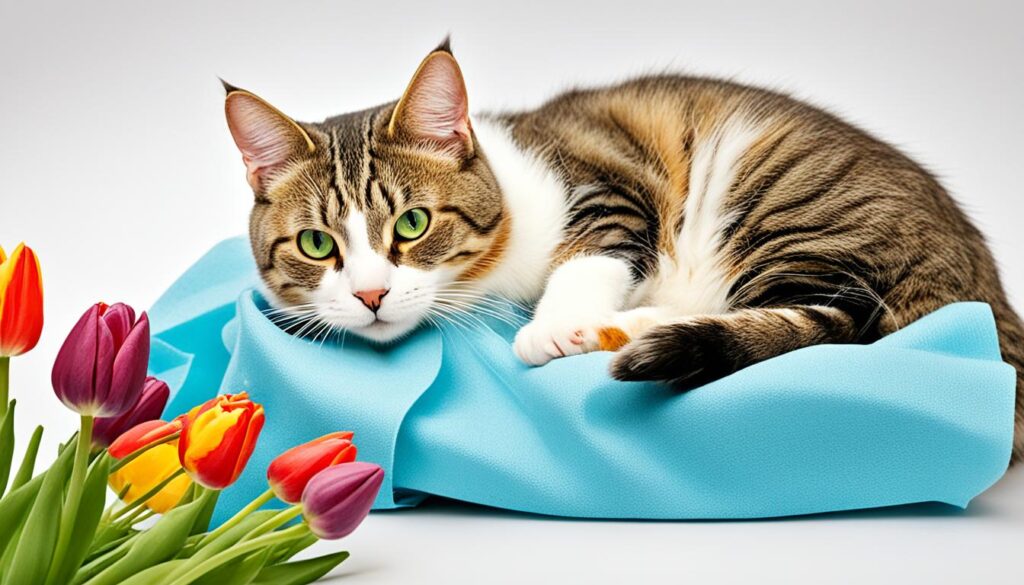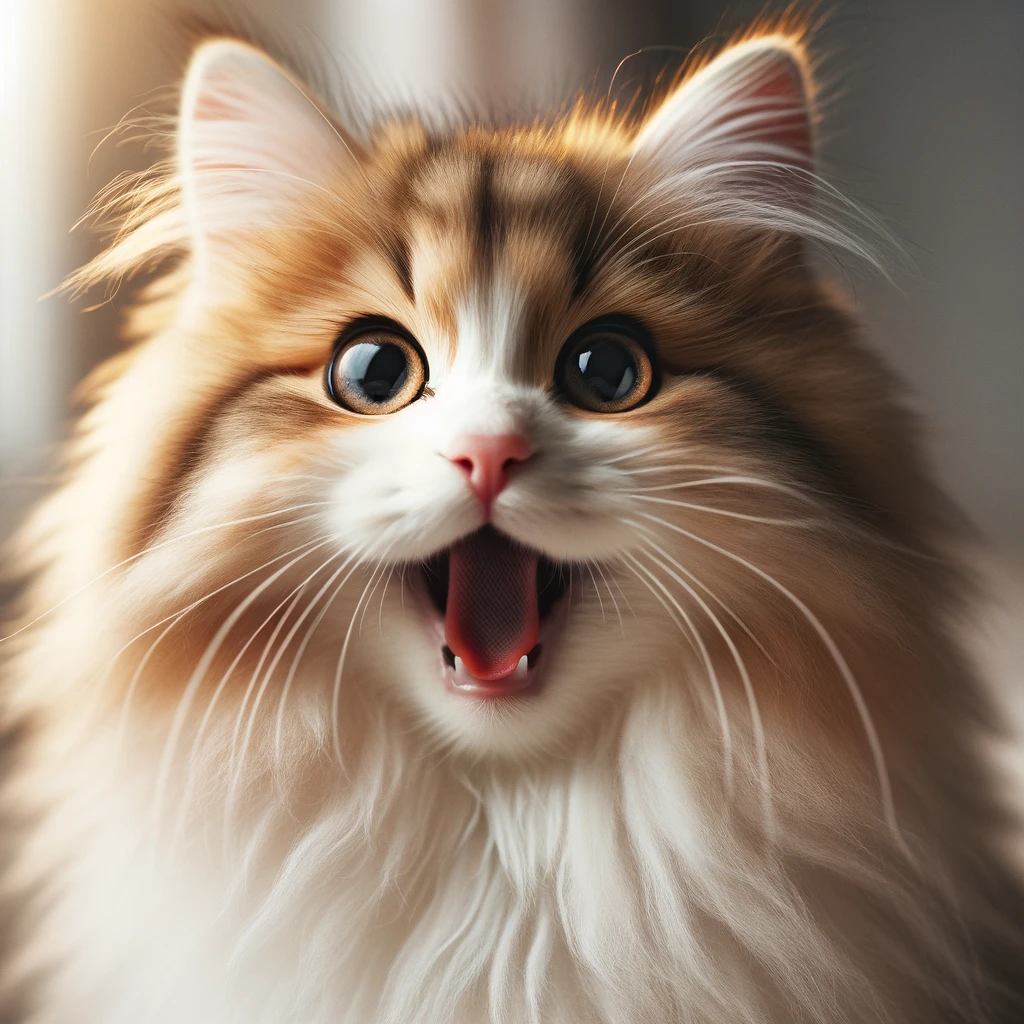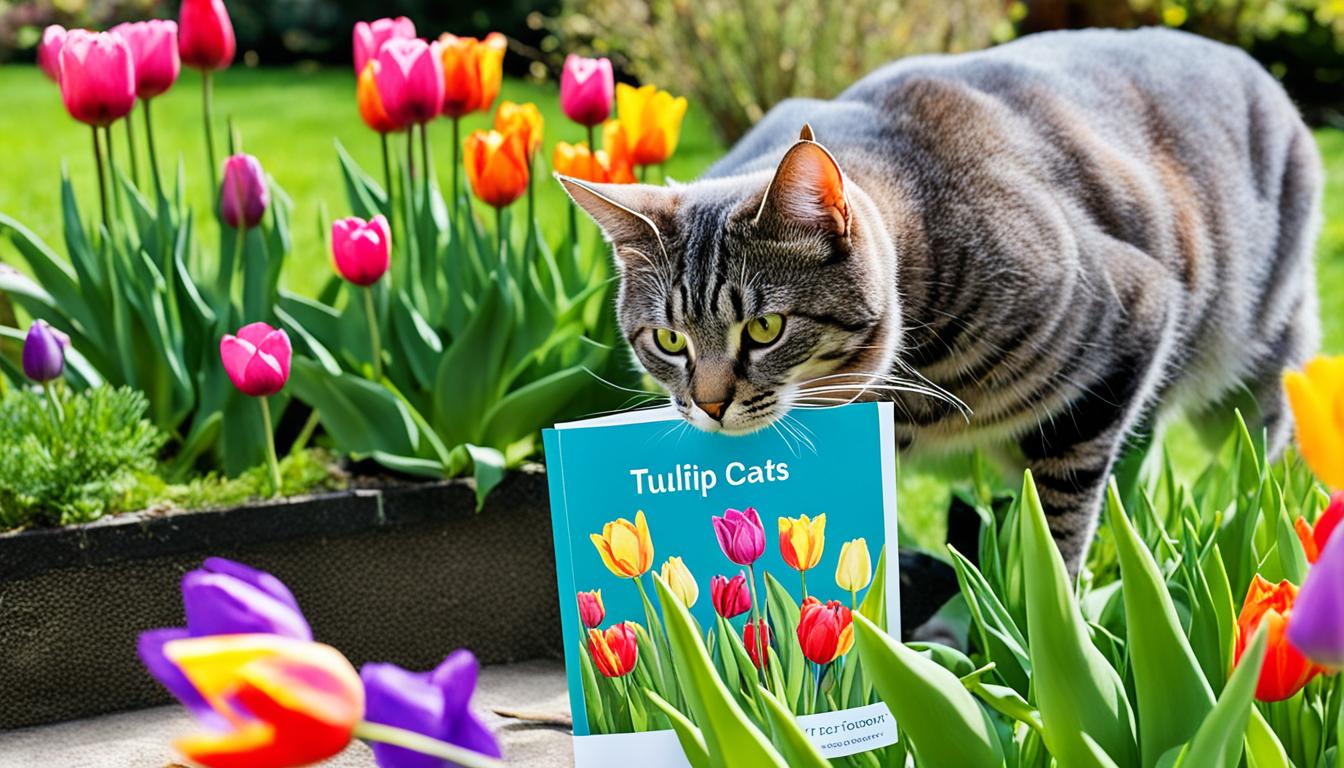As an Amazon Associate I earn from qualifying purchases.
Cats love to explore, sometimes finding trouble in beautiful tulips. It’s hard to imagine, but these flowers can be dangerous. Tulips have substances that are bad for cats. So, it’s important to be careful and keep them safe.
As a pet owner, you want to keep your cat safe. You might pick flowers that look nice but are harmful. It’s about finding a balance between having a pretty home and keeping your cat healthy.
Be wary of the danger in pretty tulips. Your carefulness can protect your cat. With the right knowledge, you can have a home that looks good and is safe for your pets.
Key Takeaways
- Understanding the risks of tulip toxicity in cats is crucial for pet safety.
- Recognize the need to keep your home and garden filled with cat-safe flowers.
- Be mindful of the dangers of tulips for cats and take necessary precautions.
- Educate yourself on the symptoms and immediate actions required should your cat be exposed to tulips.
- Ensure the beauty of your environment doesn’t compromise the health of your feline friend.
Understanding Tulip Toxicity in Cats
As a cat owner, knowing the dangers of household plants is crucial. Tulips, while beautiful, might not be safe for pets. In this part, we explore why tulip poisoning in cats worries us. We’ll see how parts of the plant differ in danger. And we learn why these flowers need cautious handling.
What Makes Tulips Harmful to Cats?
Tulips brighten any garden. But, did you ask yourself, are tulips toxic to cats? Sadly, the answer is yes. Tulips have substances like allergenic lactones harmful to cats. Eating these can lead to health issues in cats. It’s vital to spot the symptoms of tulip ingestion in cats early.
The Dangers of Tulip Bulbs Compared to Other Plant Parts
The whole tulip plant poses risks, but bulbs are worst. They pack toxins more than leaves or flowers. If a cat chews on a bulb, it might face serious tulip poisoning in cats. Keep bulbs away from where cats can reach them.
Comparing Tulip Toxicity to Other Lilies in the Family
Many lilies can tempt us with their beauty, like tulips. Yet, tulips are not alone in being dangerous. They belong to a group of plants known to harm cats. Approach all these plants with care. They have toxins harmful to your cat’s health.
Symptoms of Tulip Ingestion in Cats
As a loving cat owner, you always watch over your pet’s health. Knowing the signs of tulip ingestion in cats is key, especially when these plants bloom in spring. Spotting the signs early can help you get quick help, avoiding worse health issues.
Mild Symptoms from Nibbling on Tulips
It’s important to know the mild signs if your cat eats tulips. At first, these might look small. Yet, they show your cat might not be well.
- Vomiting
- Excessive drooling
- Diarrhea
- Depression
Mild signs often include stomach upset or feeling unwell. They tell you something’s wrong with your pet.
Severe Reactions to Tulip Bulb Ingestion
Eating the more toxic tulip bulb can cause big problems. This needs fast action.
Here is a list of the more severe reactions:
| Symptom | Description | Urgency |
|---|---|---|
| Abdominal Pain | Discomfort and tenderness, possibly signalling gastrointestinal distress. | Immediate |
| Tremors | Uncontrollable shivering or shaking, a neurological response to toxins. | Immediate |
| Tachycardia | Rapid heartbeat that can be indicative of systemic poisoning. | Immediate |
| Convulsions | Seizures that may be a sign of severe neurotoxicity and are life-threatening. | Critical |
| Increased Respiratory Rate | Fast breathing which could mean the body is struggling to oxygenate the blood efficiently. | Critical |
If severe signs appear, get your cat to the vet quickly. Waiting can lower the chances of getting better. Not all tulip eating causes big troubles, but the bulb’s toxins are always dangerous.
Choosing safe flowers for your home is best. There are safe options that keep your pet safe and let you enjoy your home’s beauty.
First Steps: What to Do if Your Cat Eats a Tulip
Finding out your cat ate a tulip can be scary, because are tulips toxic to cats is a known fact. The steps you take next are very important for your pet’s safety and health. Don’t panic, but you need to act quickly. Take any tulip pieces away from your cat. Look in your cat’s mouth for any plant pieces, and clean their fur to stop more eating.
If your cat has eaten parts of a tulip, it’s critical to get veterinary care for tulip toxicity immediately. Acting fast is key in such situations.
When you call the vet, be ready to explain everything in detail. This includes how much was eaten and which part of the tulip. This matters because bulbs are the most toxic parts. If possible, take a piece of the tulip with you. It will help the vet understand better and plan the right treatment.
- Immediately isolate your cat from the area with tulips.
- Carefully remove any residue from your cat’s mouth or coat.
- Contact your veterinarian for guidance and possible emergency treatment.
- Collect a sample of the tulip, if possible, for identification.
- Monitor your cat’s behavior closely for any signs of distress.
Ensuring your cat’s safety means keeping cats safe from toxic plants. It’s a good idea to check your home and garden. Remove any tulips or plants that could harm. Make sure all new plants are safe for cats.

Quick action and getting help from the vet is key after tulip eating. To keep your pets safe at home, avoid toxic plants. Always watch their surroundings closely.
Treatment Options for Tulip Poisoning in Cats
Knowing how to deal with treatment for cat tulip poisoning is crucial for pet owners. Quick and smart actions can greatly help cats showing symptoms of tulip ingestion in cats. Above all, preventing access to harmful plants is key to keeping your feline safe.

Emergency Treatments at the Veterinary Clinic
If you think your cat ate tulips, get vet help right away. Within hours of eating the flower, a vet can make your cat vomit. This helps get rid of the plant bits. Then, your cat might get IV fluids to stop dehydration and activated charcoal to soak up toxins. In serious situations, your cat could need more intense care at the clinic.
| Treatment | Function | Timeframe |
|---|---|---|
| Emesis (Induced Vomiting) | Remove ingested toxins | Within a few hours of ingestion |
| IV Fluids | Treat dehydration and enhance renal function | As needed, post-induction of vomiting |
| Activated Charcoal | Absorb any remaining toxins | Following emesis or when emesis isn’t possible |
| Gastric Lavage | Physically wash out stomach contents | In cases of significant or bulb ingestion |
Long-term Care Following Tulip Toxicity
Once the emergency treatment is done, your cat will still need care. It’s vital to do what the vet says during this recovery time. Your cat may need more fluids, EKG heart checks, and regular blood tests. The best way to protect your cat is by removing toxic plants from your home.
Which Flowers Are Safe? Exploring Cat-safe Alternatives
For cat lovers who enjoy gardening, knowing dangers of tulips for cats is sad. Yet, it’s key to know that cat-safe flowers are out there. They let you keep pets and plants together happily.
Being a responsible pet owner means understanding tulip poisoning in cats. For a pet-friendly garden, many safe flowers exist. Here’s a list of cat-safe plants that won’t harm your furry friends.
- African Violets: These flowers are safe for cats and add color to your home without risks.
- Roses: Though they have thorns, roses are not toxic to cats. They’re a good choice for a safe bouquet.
- Orchids: Orchids are elegant and safe for cats, perfect for those seeking refined floral beauty.
- Sunflowers: With their bright presence, sunflowers make any room—and pet—happy and safe.
It’s crucial to know the impact of every flower in your house on your cat. Here is a table listing common flowers and if they’re safe for cats:
| Flower | Toxic to Cats | Safe for Cats |
|---|---|---|
| Tulips | Yes | No |
| Lilies | Yes | No |
| Roses | No | Yes |
| Orchids | No | Yes |
| African Violets | No | Yes |
| Sunflowers | No | Yes |
If unsure about a flower’s safety, always ask a vet. They offer advice for your cat’s needs. Keeping cat-safe flowers means your cat and plants will both thrive.
Preventive Measures to Keep Cats Safe from Tulips
As a pet owner, you must know about keeping cats safe from toxic plants. Tulips are pretty but dangerous for cats. So, make sure they can’t reach them.
Removing and Replacing Toxic Plants in Your Home and Garden
Start by getting rid of tulips at home. Opt for cat-safe flowers instead. This makes home safe and enjoyable for you and your cat.
Good news: you can find many lovely, safe flowers. Choose from petunias, roses, or snapdragons. You don’t have to give up beauty for safety.
Securing Tulip Bulbs and Flower Arrangements Out of Cats’ Reach
Keep tulips away from cats when you have flowers at home. Store tulip bulbs safely. For gardens, use fences or high planters.
If you love tulips, consider fake ones. They look good but are safe. This keeps your home stylish and cat-friendly.
By doing these things, your home will be safer for cats. Always think of your pet’s safety when making choices at home.
Conclusion
In our talk about are tulips toxic to cats, we found that tulips may harm them. While tulips look pretty, they’re not safe for our cats. So, it’s key to be careful with the plants you have at home.
Helping to keep cats safe from toxic plants is very important. Being alert and informed helps you protect them from harmful tulips. If your cat eats a tulip, act fast. Take them to the vet immediately for help.
As cat owners, we should think of our pet’s health before choosing home decorations. Tulips are not safe for cats. But, you can pick safe flowers and plants. This keeps your home beautiful and safe for your beloved cat.
FAQ
Are Tulips Toxic to Cats?
What Makes Tulips Harmful to Cats?
What are the Dangers of Tulip Bulbs Compared to Other Plant Parts?
How Does Tulip Toxicity Compare to Other Lilies in the Family?
What Mild Symptoms May Occur From Nibbling on Tulips?
What are the Severe Reactions to Tulip Bulb Ingestion?
What Should You Do if Your Cat Eats a Tulip?
What are the Treatment Options for Tulip Poisoning in Cats?
Which Flowers Are Safe? What are Some Cat-Safe Alternatives?
What Preventive Measures Can Keep Cats Safe from Tulips?
How Should You Secure Tulip Bulbs and Flower Arrangements to Keep Them Out of Cats’ Reach?
As an Amazon Associate I earn from qualifying purchases.

